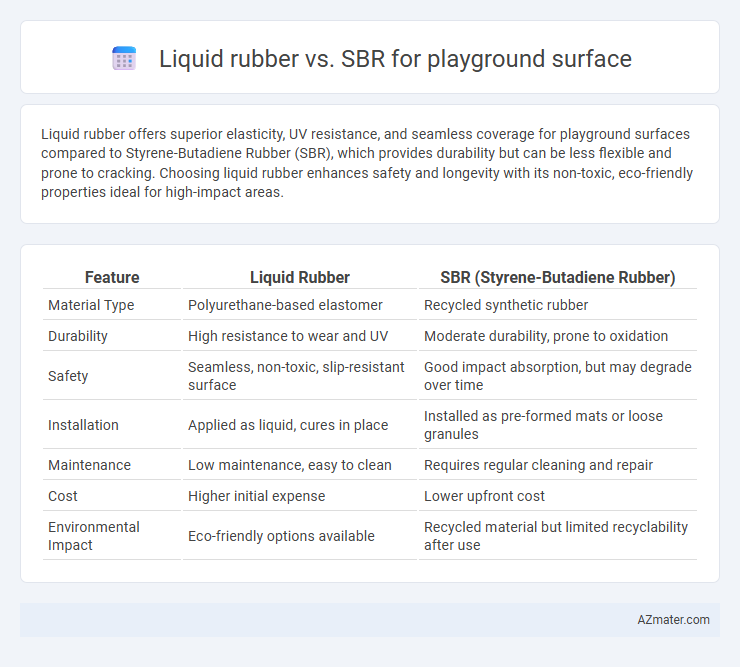Liquid rubber offers superior elasticity, UV resistance, and seamless coverage for playground surfaces compared to Styrene-Butadiene Rubber (SBR), which provides durability but can be less flexible and prone to cracking. Choosing liquid rubber enhances safety and longevity with its non-toxic, eco-friendly properties ideal for high-impact areas.
Table of Comparison
| Feature | Liquid Rubber | SBR (Styrene-Butadiene Rubber) |
|---|---|---|
| Material Type | Polyurethane-based elastomer | Recycled synthetic rubber |
| Durability | High resistance to wear and UV | Moderate durability, prone to oxidation |
| Safety | Seamless, non-toxic, slip-resistant surface | Good impact absorption, but may degrade over time |
| Installation | Applied as liquid, cures in place | Installed as pre-formed mats or loose granules |
| Maintenance | Low maintenance, easy to clean | Requires regular cleaning and repair |
| Cost | Higher initial expense | Lower upfront cost |
| Environmental Impact | Eco-friendly options available | Recycled material but limited recyclability after use |
Introduction to Playground Surfacing Materials
Liquid rubber offers superior elasticity and seamless coverage for playground surfaces, enhancing safety and shock absorption compared to traditional materials. SBR (Styrene-Butadiene Rubber) provides cost-effective, durable cushioning but may require infill and more maintenance over time. Selecting the right playground surfacing material involves balancing impact attenuation, longevity, and environmental considerations.
What is Liquid Rubber?
Liquid rubber is a versatile, synthetic elastomer applied as a seamless, durable coating for playground surfaces, known for its excellent weather resistance and high elasticity. It forms a non-toxic, slip-resistant layer that enhances safety by cushioning impacts and prevents surface degradation caused by UV rays and moisture. Compared to SBR (Styrene-Butadiene Rubber), liquid rubber offers greater customization in texture and color, making it ideal for playgrounds requiring both aesthetic appeal and long-lasting performance.
What is SBR (Styrene-Butadiene Rubber)?
SBR (Styrene-Butadiene Rubber) is a synthetic rubber commonly used in playground surfaces for its durability, shock absorption, and weather resistance. Made from a copolymer of styrene and butadiene, SBR offers excellent wear resistance, making it ideal for high-traffic areas. It is often recycled from automobile tires, providing an eco-friendly and cost-effective option for playground safety surfacing.
Key Differences Between Liquid Rubber and SBR
Liquid rubber offers a seamless, waterproof surface with excellent UV resistance and durability, making it ideal for playgrounds requiring smooth, slip-resistant areas. SBR (Styrene-Butadiene Rubber) provides superior shock absorption and cushioning, commonly used in loose-fill or bonded playground surfaces to enhance safety and reduce injury risk. While liquid rubber requires professional application for uniform coverage, SBR is easier to install and more cost-effective but may require periodic replenishment due to material displacement or degradation.
Safety Performance: Liquid Rubber vs SBR
Liquid rubber provides superior shock absorption and slip resistance compared to SBR, significantly reducing the risk of injuries on playground surfaces. Its seamless, non-toxic composition minimizes abrasions and eliminates harmful dust associated with SBR crumb rubber. Enhanced durability and UV stability in liquid rubber also maintain consistent safety performance over time.
Durability and Maintenance Comparison
Liquid rubber offers superior durability compared to SBR for playground surfaces, resisting UV rays, cracking, and harsh weather conditions over time. Maintenance requirements for liquid rubber are minimal, requiring only occasional cleaning to maintain its elasticity and appearance. In contrast, SBR surfaces tend to degrade faster under heavy use, need more frequent repairs, and may require replacement within a few years due to wear and tear.
Installation Process: Liquid Rubber vs SBR
Liquid rubber playground surfaces involve a seamless, spray-applied installation that cures quickly, creating a durable and flexible layer with minimal downtime. In contrast, SBR (Styrene-Butadiene Rubber) surfaces require poured-in-place mixing and spreading of crumb rubber and binder, followed by precise leveling and curing, which can extend installation time. Liquid rubber offers easier customization around complex shapes and quicker return-to-use compared to the labor-intensive SBR process.
Environmental Impact and Sustainability
Liquid rubber for playground surfaces offers superior environmental benefits due to its eco-friendly composition, often made from recycled materials and non-toxic ingredients that minimize pollutant runoff. SBR (Styrene-Butadiene Rubber) surface, commonly derived from recycled tires, poses concerns related to microplastic shedding and possible chemical leaching, which can negatively impact soil and water quality. Liquid rubber's biodegradability and lower VOC emissions enhance sustainability, making it a preferable choice for environmentally conscious playground installations.
Cost Analysis and Value for Playground Projects
Liquid rubber offers higher upfront costs compared to SBR but provides superior durability and lower long-term maintenance expenses, making it cost-effective over time for playground surfaces. SBR, being less expensive initially, may incur frequent repairs and replacement costs due to lower resilience and UV resistance. Evaluating total life cycle costs, liquid rubber delivers greater value for playground projects through enhanced safety, aesthetics, and longevity.
Choosing the Best Option for Your Playground
Liquid rubber offers superior durability and flexibility for playground surfaces, providing excellent shock absorption and weather resistance that enhances child safety and longevity. SBR (Styrene-Butadiene Rubber) is a cost-effective alternative with good abrasion resistance but may require more frequent maintenance and has less flexibility compared to liquid rubber. Selecting the best option depends on budget, maintenance capacity, and desired performance; liquid rubber suits high-traffic areas demanding long-term resilience, while SBR fits moderate-use playgrounds with tighter budgets.

Infographic: Liquid rubber vs SBR for Playground surface
 azmater.com
azmater.com